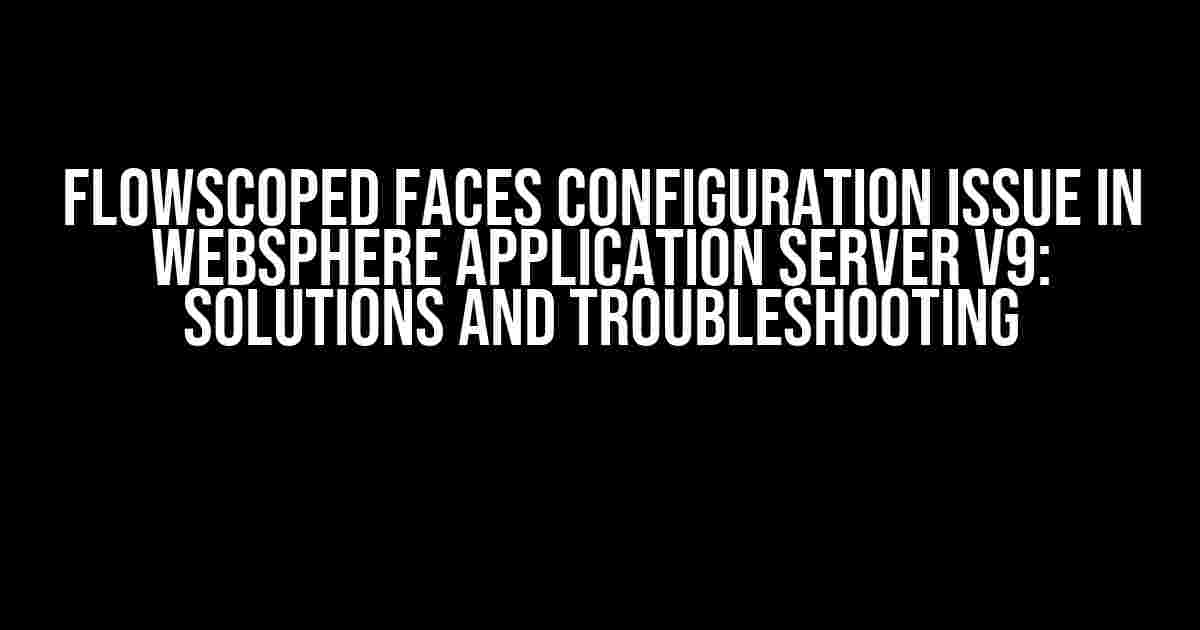Overview of FlowScoped Faces and WebSphere Application Server V9
FlowScoped Faces is a JavaServer Faces (JSF) feature that enables the use of flow-scoped beans, which are beans that are scoped to a specific flow. WebSphere Application Server V9 is a popular Java-based web application server that supports JSF-based applications. However, sometimes, users may encounter configuration issues when using FlowScoped Faces in WebSphere Application Server V9.
The FlowScoped Faces Configuration Issue
The most common configuration issue with FlowScoped Faces in WebSphere Application Server V9 is related to the incorrect setup of the faces-config.xml file. The faces-config.xml file is used to configure the JSF implementation and is critical for the proper functioning of FlowScoped Faces.
Symptoms of the Issue
- Error messages indicating that the flow-scoped bean is not found
- JSF pages failing to render properly
- Application deployment failures due to configuration errors
Troubleshooting Steps
-
Verify the faces-config.xml file configuration:
- Check that the faces-config.xml file is correctly configured to enable FlowScoped Faces
- Ensure that the flow-scoped beans are properly defined and registered in the faces-config.xml file
-
Check the JSF implementation configuration:
- Verify that the JSF implementation is correctly configured in the web.xml file
- Ensure that the JSF servlet is properly mapped in the web.xml file
-
Verify the WebSphere Application Server V9 configuration:
- Check that the WebSphere Application Server V9 is correctly configured to support JSF-based applications
- Ensure that the JSF libraries are properly installed and configured in the WebSphere Application Server V9
Resolution
By following the troubleshooting steps outlined above, users should be able to resolve the FlowScoped Faces configuration issue in WebSphere Application Server V9. It is essential to ensure that the faces-config.xml file is correctly configured, the JSF implementation is properly set up, and the WebSphere Application Server V9 is correctly configured to support JSF-based applications.
Conclusion
In conclusion, the FlowScoped Faces configuration issue in WebSphere Application Server V9 is typically caused by incorrect setup of the faces-config.xml file or misconfiguration of the JSF implementation. By following the troubleshooting steps outlined in this article, users should be able to resolve the issue and ensure that their JSF-based applications function correctly in WebSphere Application Server V9.
Here are 5 questions and answers about “FlowScoped Faces configuration issue in WebSphere Application Server V9” in the specified format:
Frequently Asked Question
If you’re stuck with FlowScoped Faces configuration issues in WebSphere Application Server V9, we’ve got you covered! Here are some frequently asked questions to get you back on track:
What is the primary cause of FlowScoped Faces configuration issues in WebSphere Application Server V9?
The primary cause of FlowScoped Faces configuration issues in WebSphere Application Server V9 is often related to incorrect or missing configurations in the faces-config.xml file, which can lead to failures in FacesFlowscoped beans.
How can I troubleshoot FlowScoped Faces configuration issues in WebSphere Application Server V9?
To troubleshoot FlowScoped Faces configuration issues, start by reviewing the server logs for errors, then verify that the faces-config.xml file is correctly configured and deployed. You can also try enablingFaces debug logging to get more detailed information about the issue.
What are some common FlowScoped Faces configuration issues in WebSphere Application Server V9?
Some common FlowScoped Faces configuration issues in WebSphere Application Server V9 include incorrect beans.xml file configurations, missing or duplicate faces-config.xml files, and incorrect namespace declarations.
Can I use Java-based configuration instead of faces-config.xml for FlowScoped Faces in WebSphere Application Server V9?
Yes, in WebSphere Application Server V9, you can use Java-based configuration using the `@FacesConfig` annotation instead of the faces-config.xml file for configuring FlowScoped Faces.
Are there any specific WebSphere Application Server V9 settings that can affect FlowScoped Faces configuration?
Yes, some WebSphere Application Server V9 settings, such as the `com.ibm.ws.jsf.ENABLE_FACES_CONFIG_EXTENSION` property, can affect FlowScoped Faces configuration. Make sure to review the server settings to ensure they are correctly configured for your application.
